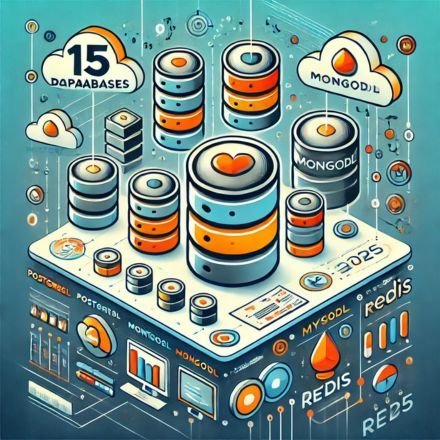15 Top Databases to Power Your Web Applications in 2025
Whether you’re developing an e-commerce site, a social media platform, or a corporate SaaS product, selecting the right database can determine your application’s performance and scalability.

In today’s fast-paced digital landscape, choosing the right database is crucial for building and maintaining robust web applications. As we move into 2025, databases are becoming more powerful, scalable, and adaptable to meet diverse application needs.
Here’s an in-depth look at the 15 top databases that will empower your web applications in 2025, along with their key features and ideal use cases.
- PostgreSQL
Why Choose PostgreSQL?
PostgreSQL is an open-source relational database renowned for its robustness and advanced features. It supports complex queries, JSON, and XML data types, making it ideal for dynamic web applications.
Key Features:
- ACID compliance for reliable transactions.
- Advanced indexing and full-text search.
- Support for stored procedures in multiple programming languages.
Ideal For:
E-commerce platforms, analytics applications, and content management systems.
- MySQL
Why Choose MySQL?
A staple in web development, MySQL powers millions of applications worldwide. Its simplicity and reliability make it a go-to choice for developers.
Key Features:
- Scalability for small to large applications.
- High availability with clustering and replication.
- Strong community support.
Ideal For:
Blogs, e-commerce stores, and SaaS applications.
- MongoDB
Why Choose MongoDB?
MongoDB is a NoSQL database designed for flexibility and scalability. Its schema-less architecture is perfect for handling unstructured data.
Key Features:
- JSON-like document storage.
- Horizontal scaling with sharding.
- Real-time analytics capabilities.
Ideal For:
Content-rich applications, IoT systems, and real-time analytics.
- Redis
Why Choose Redis?
Redis is an in-memory key-value store known for its lightning-fast performance. It’s often used as a caching layer to accelerate applications.
Key Features:
- Sub-millisecond response times.
- Support for data structures like hashes, lists, and sets.
- Pub/Sub capabilities for real-time messaging.
Ideal For:
Caching, session management, and real-time applications.
- Microsoft SQL Server
Why Choose SQL Server?
Microsoft’s relational database offers excellent integration with the Azure ecosystem and provides powerful tools for business intelligence.
Key Features:
- Built-in AI and machine learning capabilities.
- Enhanced security with data encryption.
- High availability with Always On.
Ideal For:
Enterprise applications, financial systems, and ERP solutions.
- Oracle Database
Why Choose Oracle?
Oracle Database is a premium choice for mission-critical applications requiring top-notch performance and security.
Key Features:
- Multi-model data management.
- Advanced data analytics tools.
- High-performance scalability.
Ideal For:
Enterprise-level CRM, financial systems, and data warehouses.
- SQLite
Why Choose SQLite?
SQLite is a lightweight, file-based database perfect for small to medium-scale applications with straightforward needs.
Key Features:
- Zero configuration and serverless.
- Portable and easy to deploy.
- Supports ACID transactions.
Ideal For:
Mobile apps, desktop applications, and embedded systems.
- Cassandra
Why Choose Cassandra?
Apache Cassandra excels at managing massive amounts of data across multiple servers with no single point of failure.
Key Features:
- Distributed architecture for high availability.
- Linear scalability.
- Support for time-series data.
Ideal For:
Social media platforms, IoT applications, and large-scale analytics.
- MariaDB
Why Choose MariaDB?
MariaDB, a fork of MySQL, combines enterprise features with open-source flexibility.
Key Features:
- Improved storage engines.
- Support for distributed SQL.
- Strong focus on security.
Ideal For:
Web applications, analytics, and cloud-based systems.
- Firebase Realtime Database
Why Choose Firebase?
Firebase offers a real-time NoSQL database optimized for mobile and web apps, backed by Google’s robust infrastructure.
Key Features:
- Real-time data synchronization.
- Offline capabilities.
- Easy integration with other Firebase services.
Ideal For:
Chat applications, collaborative tools, and mobile apps.
- Elasticsearch
Why Choose Elasticsearch?
Elasticsearch is a search and analytics engine that’s perfect for handling large volumes of semi-structured data.
Key Features:
- Full-text search.
- Near real-time indexing.
- Horizontal scaling.
Ideal For:
Search-heavy applications and log analytics.
- Couchbase
Why Choose Couchbase?
Couchbase combines NoSQL flexibility with SQL-like querying, offering scalability and high performance.
Key Features:
- JSON document storage.
- Built-in caching.
- Support for mobile synchronization.
Ideal For:
Gaming, IoT systems, and high-speed transactions.
- DynamoDB
Why Choose DynamoDB?
Amazon DynamoDB is a fully managed NoSQL database designed for performance and scalability.
Key Features:
- Serverless with automatic scaling.
- Low-latency response times.
- Multi-region replication.
Ideal For:
E-commerce platforms, IoT systems, and real-time applications.
- Neo4j
Why Choose Neo4j?
Neo4j is a graph database ideal for managing highly connected data. It’s widely used in applications requiring relationship analysis.
Key Features:
- Intuitive graph data model.
- Powerful query language (Cypher).
- High-performance graph traversals.
Ideal For:
Social networks, recommendation systems, and fraud detection.
- CockroachDB
Why Choose CockroachDB?
CockroachDB is a distributed SQL database designed to survive failures and ensure data integrity.
Key Features:
- Distributed architecture for fault tolerance.
- Global scalability.
- ACID compliance.
Ideal For:
Global applications, financial systems, and SaaS platforms.
Read More:- 11 Best Practices for Secure Web Applications
Conclusion
Selecting the right Database Development Services is a critical decision that directly impacts your web application’s performance, scalability, and user experience. The databases listed above cater to diverse needs and industries with options ranging from relational giants like PostgreSQL and MySQL to NoSQL powerhouses like MongoDB and DynamoDB. As you plan your 2025 projects, consider your application’s requirements and choose a database that aligns with your goals for efficiency and growth.
What's Your Reaction?












